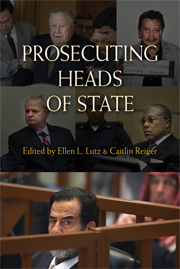Book contents
- Frontmatter
- Contents
- List of Contributors
- About the International Center for Transitional Justice
- Foreword
- Preface
- 1 Introduction
- 2 Prosecutions of Heads of State in Europe
- 3 Prosecutions of Heads of State in Latin America
- 4 The Multiple Prosecutions of Augusto Pinochet
- 5 A Leader Takes Flight: The Indictment of Alberto Fujimori
- 6 Charm and Punishment: How the Philippines' Leading Man Became Its Most Famous Prisoner
- 7 Shifting Legitimacy: The Trials of Frederick Chiluba
- 8 A Justice “Trickle-Down”: Rwanda's First Postgenocide President on Trial
- 9 Justice Squandered? The Trial of Slobodan Milošević
- 10 A Big Man in a Small Cell: Charles Taylor and the Special Court for Sierra Leone
- 11 Political Pedagogy, Baghdad Style: The Dujail Trial of Saddam Hussein
- 12 Conclusion
- APPENDIX: List of Prosecutions of Heads of State or Government since 1990
- Selected Bibliography
- Index
5 - A Leader Takes Flight: The Indictment of Alberto Fujimori
Published online by Cambridge University Press: 06 August 2009
- Frontmatter
- Contents
- List of Contributors
- About the International Center for Transitional Justice
- Foreword
- Preface
- 1 Introduction
- 2 Prosecutions of Heads of State in Europe
- 3 Prosecutions of Heads of State in Latin America
- 4 The Multiple Prosecutions of Augusto Pinochet
- 5 A Leader Takes Flight: The Indictment of Alberto Fujimori
- 6 Charm and Punishment: How the Philippines' Leading Man Became Its Most Famous Prisoner
- 7 Shifting Legitimacy: The Trials of Frederick Chiluba
- 8 A Justice “Trickle-Down”: Rwanda's First Postgenocide President on Trial
- 9 Justice Squandered? The Trial of Slobodan Milošević
- 10 A Big Man in a Small Cell: Charles Taylor and the Special Court for Sierra Leone
- 11 Political Pedagogy, Baghdad Style: The Dujail Trial of Saddam Hussein
- 12 Conclusion
- APPENDIX: List of Prosecutions of Heads of State or Government since 1990
- Selected Bibliography
- Index
Summary
THE ANTECEDENTS
Peru's internal armed conflict between 1980 and 2000 was the most intense and prolonged period of violence in the republic's history. The most reliable fatality estimate is the Peruvian Truth and Reconciliation Commission's (TRC) figure of 69,280. Of the victims, 79 percent lived in rural areas, 75 percent spoke either Quechua or another indigenous language as their mother tongue, and 56 percent worked in agriculture.
The violence was initiated by armed acts against the state by Sendero Luminoso (the Shining Path), an ideologically communist, fundamentalist, totalitarian organization, with terrorist and genocidal tendencies. The Shining Path was responsible for carrying out crimes against humanity, as well as grave breaches of international humanitarian law. Its militants were responsible for 54 percent of the deaths and disappearances reported to the TRC. The Tupac Amaru Revolutionary Movement (MRTA), a smaller contemporaneous revolutionary movement, was responsible for 1.5 percent of the fatalities registered by the TRC.
Successive democratic governments adopted military responses to deal with these terrorist groups that aggravated the situation. At first, the armed forces carried out indiscriminate repression against those they suspected of belonging to or collaborating with the Shining Path. Later they became more selective in their practices, which nonetheless led to forced disappearances, extrajudicial executions, rape, and torture.
- Type
- Chapter
- Information
- Prosecuting Heads of State , pp. 95 - 110Publisher: Cambridge University PressPrint publication year: 2009
- 1
- Cited by

